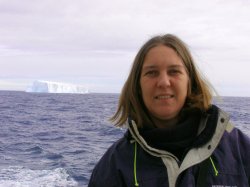NSF Award Lets Professor Look Back to the Future
Data from millions of years ago will be used to predict Antarctic ice sheet response to global warming
Posted in: Research, Science and Technology

Earth and Environmental Studies Professor Sandra Passchier is a pioneering polar scientist in the relatively young, 60-year-old, field of internationally coordinated Antarctic research. She made her first polar trip to Greenland in 1992, as the only woman on a field team and has since visited Antarctica five times. She is planning her sixth trip in early 2019.
The Antarctic ice sheet (AIS) covers 5.4 million square miles, or 98 percent, of a continent roughly the size of North America – and Passchier’s research efforts are devoted to exposing the secrets of AIS dynamics. A recent $323,113 award from the National Science Foundation (NSF) supports her three-year project that will help scientists forecast sea level rise the world over.
Passchier is focusing project research on West Antarctica because the sea level rise due to ice melt there has tripled in the past 15 years. “Gravity causes the water released from West Antarctica to have a greater effect on the U.S. East Coast than elsewhere and makes the sea level rise here greater than the global average,” she explains. “Understanding how the West Antarctica ice sheets responds to global warming is crucial in providing accurate sea level predictions.”
As a team member on previous international science drilling programs, she helped to extract sedimentary core samples from hundreds of meters beneath the West Antarctica sea floor. By analyzing these archived samples, Passchier hopes to reconstruct the timing and spatial distribution of Antarctic ice growth during the greenhouse to icehouse climate change of 37 to 33 million years ago that affected the entire planet. While her NSF award funds Passchier’s work on existing core samples, she hopes to join an International Ocean Discovery Program expedition to the Amundsen Sea in West Antarctica from January to March 2019, and collect additional samples.
By going back in time to show the effect of greenhouse forcing on ice sheet development, she says her findings “will help us to understand how ice sheets and sea level behaved under conditions of higher levels of greenhouse gases in the atmosphere than we have today – levels that are similar to those we will reach in a few decades if these emissions aren’t curtailed or mitigated.”
Passchier believes that while ongoing warming cannot be immediately reversed, governments and individuals can take action. “Ice sheet and climate scientists have long agreed that keeping the warming globally below 2 degrees centigrade is essential in order to prevent irreversible and catastrophic effects on human populations,” she notes. “While current government commitments of different countries aren’t enough to get us there, it is encouraging to see that students and others aren’t waiting for their governments to act. Many are taking steps – such as consuming less meat, lowering their thermostats and taking public transportation – to minimize their carbon footprint.”
Both undergraduate and graduate students will be involved in various phases of Passchier’s three-year project, including the sampling of drill cores in the Gulf Coast Core Repository at Texas A&M University; the preparation and analysis of samples in the Montclair State lab; co-authoring journal articles; and ultimately communicating the results and importance of this project to stake holders, policy makers, students and the general public.
“Passchier’s work is not only of great scientific importance but also exemplifies how, as a national- and state-designated research university, Montclair State is conducting research of international consequence,” says Vice Provost for Research and Graduate School Dean Scott Herness. “I’m pleased, too, that our undergraduate and graduate students can participate in research experiences of this caliber.”
Passchier, who recently contributed to an article in Nature Communications that summarizes how the AIS interacts with the ocean and with land, believes results of her new project will contribute significantly to the paleo-climate data needed to project the AIS response to continued global warming.
“Our current greenhouse gas levels are higher than at any time in human history. To understand this climate state, we need to assess earth processes from millions of years back in time and study the history of the AIS and climate system in the geological archives that are buried in layers of mud under Antarctica’s sea floor.”
